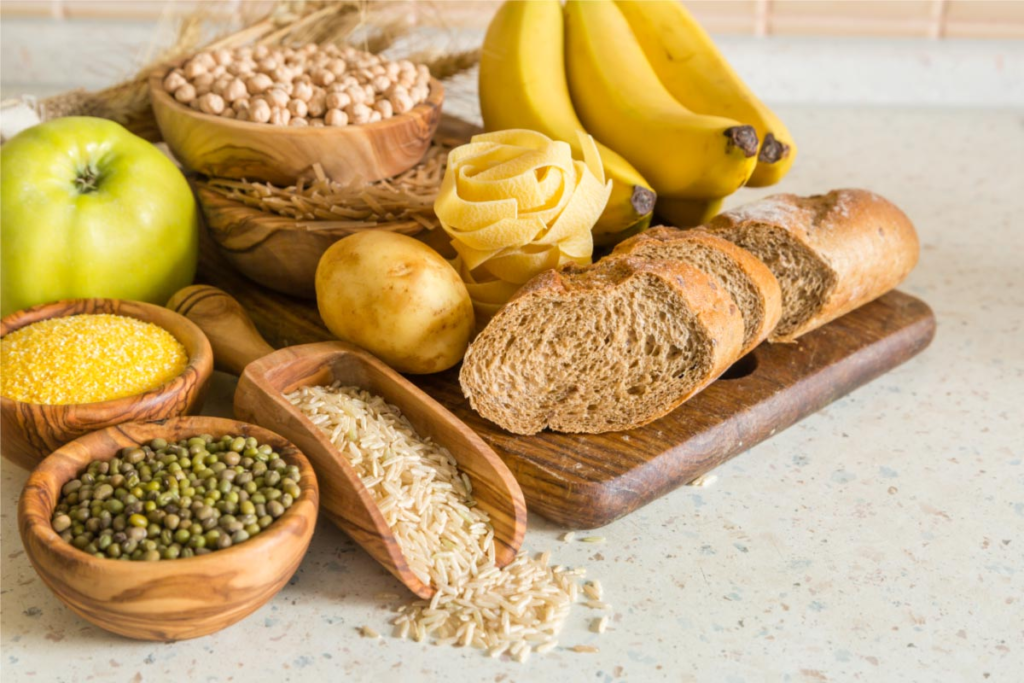A low-carb diet focuses on minimizing carbohydrate intake to encourage the body to burn fat for fuel instead of glucose.
This approach promotes weight loss, improves blood sugar levels, and enhances overall health by prioritizing proteins, fats, and low-carb vegetables while reducing sugars and starches.
To Do a Low Carb Diet Correctly
To do a low-carb diet correctly, focus on nutrient-dense foods for sustained energy.
Watch out for high glycemic index foods causing energy spikes. Opt for weight loss benefits by burning stored fat. Stay away from carb-rich foods like bread and sugary drinks.
Control hidden sugars in sauces and snacks. Experiment with tasty low-carb meals like scrambled eggs and dark chocolate.
Portion control is key to avoid overeating. Keep satisfying snacks handy, like nuts and cucumber with cream cheese. Discover how to optimize your diet for best results.

Understanding Carbohydrates
Understanding carbohydrates better involves focusing on their role in your body’s energy production. Carbohydrates are your body’s primary source of fuel, providing the energy needed for daily activities.
When considering your carb count, it’s crucial to be mindful of the glycemic index. This measures how quickly a carbohydrate-containing food raises your blood sugar levels.
Foods with a high glycemic index can cause rapid spikes and crashes in energy levels, leading to cravings and mood swings.
Benefits of a Low Carb Diet
Understanding carbohydrates plays a key role in appreciating the benefits of a low-carb diet.
By reducing your carb intake, you can experience significant weight loss as your body switches to burning stored fat for energy. This shift not only helps in shedding excess pounds but also enhances your energy levels throughout the day.
Additionally, a low carb diet can aid in regulating blood sugar levels, preventing drastic spikes and crashes that often lead to fatigue. Furthermore, it can positively impact your cholesterol levels, promoting heart health and overall well-being.
Embracing a low-carb lifestyle empowers you to take control of your health, offering a path to a lighter, more energetic, and balanced you.
Foods to Eat on a Low Carb Diet
Reducing your carb intake on a low-carb diet involves focusing on consuming nutrient-dense foods that are rich in essential vitamins and minerals.
When looking for low carb options, consider incorporating delicious low carb desserts to satisfy your sweet cravings without the guilt. Opt for sugar-free jello, chia seed pudding, or dark chocolate with at least 70% cocoa content.
For low-carb breakfasts, enjoy scrambled eggs with spinach, avocado, and cheese, or Greek yogurt with nuts and seeds. These options will keep you energized throughout the morning without the need for high-carb foods.
Foods to Avoid on a Low Carb Diet
When following a low carb diet, you should steer clear of carb-rich foods and hidden sugar sources. Avoid items like bread, pasta, and sugary drinks to keep your carb intake in check.
Be mindful of sauces, condiments, and processed snacks that may contain hidden sugars that can derail your progress.
Carb-Rich Foods
To succeed on a low carb diet, it’s important to steer clear of carb-rich foods that can hinder your progress and impact your health negatively. When carb counting, be wary of foods like sugary treats, bread, pasta, rice, and starchy vegetables, as they can quickly add up and sabotage your efforts.
Instead, focus on foods with low net carbs and high fiber intake, such as leafy greens, nuts, seeds, and lean proteins.
These choices can help you feel full longer and support your digestive health.
Hidden Sugar Sources
Steer clear of hidden sugar sources when following a low-carb diet to avoid sabotaging your progress and compromising your health goals. Keep an eye out for sneaky ingredients like high-fructose corn syrup, maltodextrin, and dextrose, which can sneak into seemingly healthy foods.
Foods labeled as ‘low fat’ or ‘diet’ often contain added sugars to enhance flavor. Additionally, be cautious with condiments such as ketchup, barbecue sauce, and salad dressings as they can be loaded with hidden sugars.
Opt for sugar substitutes like stevia, erythritol, or monk fruit to sweeten your meals without the added carbs.
By being mindful of these hidden sugar sources and making smarter choices, you can stay on track with your low carb diet and achieve your health objectives.

Foods Suitable for a Low-Carb Diet
Meat, Poultry, and Fish
- Beef: Ground beef, steak, roast (choose lean cuts)
- Chicken: Breast, thighs, drumsticks
- Pork: Tenderloin, chops, loin
- Fish: Salmon, tuna, cod, trout, sardines
- Shellfish: Shrimp, crab, lobster, mussels, oysters
Eggs
- Whole eggs (yolks and whites) are incredibly versatile and nutrient-dense
Non-Starchy Vegetables
- Leafy greens: Spinach, kale, lettuce, arugula, Swiss chard
- Broccoli
- Cauliflower
- Brussels sprouts
- Asparagus
- Green beans
- Mushrooms
- Bell peppers
Low-Carb Fruits
- Berries: Strawberries, blueberries, raspberries, blackberries
- Avocados: A unique, fatty fruit that’s low in carbs and high in fiber
- Olives
Nuts and Seeds
- Almonds
- Walnuts
- Macadamia nuts
- Sunflower seeds
- Pumpkin seeds
- Chia seeds
High-Fat Dairy
- Full-fat plain yogurt (Greek yogurt is a good option)
- Cheese: Cheddar, mozzarella, brie, goat cheese, etc.
- Heavy cream
Fats and Oils
- Olive oil
- Avocado oil
- Coconut oil
- Butter
Remember: Eating a low-carb diet is about choosing whole, unprocessed foods whenever possible. It’s best to consult with a healthcare professional or registered dietician for personalized guidance on a low-carb diet plan.
Meal Planning Tips
Planning your meals in advance can greatly aid in sticking to your low-carb diet goals.
Start by focusing on portion control to make sure you’re not overeating, even low carb foods.
Preparing meals ahead of time not only saves you effort during the week but also helps in controlling your carb intake. Experiment with recipe variations to keep your meals exciting and prevent boredom.
Try different seasonings, cooking methods, and ingredient combinations to discover what works best for you.
Snack Ideas for a Low Carb Diet
When following a low carb diet, having satisfying and nutritious snack options readily available is essential. Quick recipes can be a lifesaver for busy days.
Try making a simple snack by pairing sliced cucumbers with cream cheese or almond butter. These combinations offer a good balance of nutrients while keeping your carb intake in check.
Another idea is to prepare a handful of mixed nuts and seeds for a quick and crunchy snack.
Hard-boiled eggs are also a fantastic option, providing protein and healthy fats to keep you full between meals.
Staying Consistent and Motivated
To maintain progress on your low-carb diet journey, staying consistent and motivated is key.
Start by making a mindset shift – view your diet as a lifestyle choice rather than a temporary fix. Remind yourself of the reasons you started and focus on how it aligns with your long-term goals.
Celebrate small wins along the way to keep yourself motivated and engaged. Additionally, accountability partners can be incredibly beneficial. Share your goals with a friend or family member who can support and encourage you.
Having someone to check in with can help you stay on track and push through any challenging times.

We Hope This Helps
To sum up, adhering to a low-carb diet can result in numerous health benefits, such as weight loss and enhanced blood sugar control.
By familiarizing yourself with which foods to consume and which to steer clear of, along with incorporating meal planning suggestions and snack ideas, you can effectively navigate a low-carb lifestyle.
Stay persistent and motivated on your journey to improved health, and relish the positive outcomes that stem from reducing your carb intake.
Keep up the great work!

